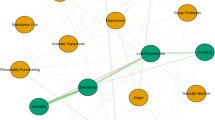Abstract
Objective.The Verbal Numerical Scale (VNS) for rating pain isbounded between 0 (= no pain) and 10 (= worst pain imaginable). Wehypothesized that the limitations inherent to this boundary when ratingextremely painful stimuli may be identified by integrating the VNS with anunbounded score such as magnitude estimation of relative change. Methods.Volunteers received stimuli of increasing current via cutaneous electrodesuntil they rated > 5 on the VNS scale. This stimulus, termed S, wasarbitrarily assigned a magnitude estimate of 100%. Then, stimuli of varyingcurrents were delivered; two were 10 mA and 20 mA higher than S(S+10 and S+20), two were 1/2 of the current for the Sstimulus (S1/2), and one was at the original current(Srepeat). The pain elicited by each stimulus was scored inproportion to the S stimulus. The extrapolated VNS score (VNSext)was determined by multiplying this magnitude estimate (%) by the VNS score forS. Main Results.Seventy percent of the stimuli with higher intensitythan S generated a VNSext score above 10. The mean magnitudeestimations for S+10 and S+20 were 186% and 242%: theygenerated mean (median) VNSext values of 12.4 [12] and16.2 [14], respectively (p = 0.019 for the differencebetween them by Wilcoxon signed rank test). Conclusions.The combineduse of VNS and magnitude estimation confirmed that the ceiling of the boundedpain scale may significantly limit a patient's ability to describe a newpain stimulus. VNSext may provide a means of overcoming thislimitation.
Similar content being viewed by others
REFERENCES
Murphy DM, McDonald A, Power C, Unwin A, Mac Sullivan R. Measurement of pain: Comparison of the visual analogue with a nonvisual analogue scale. Clin J Pain 1988; 3: 197–199
Campbell IG, Carstens E, Watkins LR. Comparison of human pain sensation and £exion withdrawal evoked by noxious radiant heat. Pain 1991; 45: 259–268
White P. Pain measurement. In: War¢eld CA, ed. Princi-ples and practice of pain management. McGraw-Hill, 1993
Duncan GH, Bushnell MC, Lavigne GJ. Comparison of verbal and visual analogue scales for measuring the inten-sity and unpleasantness of experimental pain. Pain 1989; 37: 295–303
Gracely RH. Studies of pain in normal man. In: Wall PD, Melzack R, eds. Textbook of pain, 3rd ed. Churchill Livingstone, 1994: 317
Engen T. Psychophysics II. Scaling methods. In: Kling JW, Riggs LA, eds.Woodworth & Schlossberg's exper-imental psychology, 3rd ed. Holt, New York: Rinehart andWinston Inc., 1971: 73–79
Stevens SS, Carton AS, Shickman GM. A scale of appa-rent intensity of electric shock. J Exp Psych 1958; 56: 328–334
DeBroucker T, Willer JC, Bergeret S. The nociceptive £exion re£ex in humans: A speci¢c and objective corre-late of experimental pain. In: Chapman CR, Loeser JD, eds. Issues in pain management. NewYork: Raven Press, 1989: 337–352
Lundell JC, Silverman DG, Brull SJ, O'Connor TZ, Kitahata LM, Collins JG, LaMotte R. Reduction of 458 Journal of ClinicalMonitoring and Computing Vol 15 Nos 7–8 December 1999 postburn hyperalgesia after local injection of ketorolac in healthy volunteers. Anesthesiology 1996; 84: 502–509
Price DD, Bush FM, Long S, Harkins SW. A comparison of pain measurement characteristics of mechanical visual analogue and simple numerical rating scales. Pain 1994; 56: 217–226
Price DD, McGrath PA, Ra¢i A, Buckingham B. The validation of visual analogue scales as ratio scale measures for chronic and experimental pain. Pain 1983; 17: 45–56
Huskisson EC. Measurement of pain. Lancet 1974 (Nov): 1127–1131
Huskisson EC. Visual analogue scales. In: Melzack R, ed. Pain measurement and assessment. New York: Raven Press, 1983: 33–37
Petersen-Felix S, Zbinden AM, Fischer M, Thomson DA. Iso£urane minimum alveolar concentration decreases during anesthesia and surgery. Anesthesiology 1993; 79: 959–965
Saidman LJ, Eger EI. E¡ect of nitrous oxide and of narcotic premedication on the alveolar concentration of halothane required for anesthesia. Anesthesiology 1964; 25: 302–306
Hornbein TF, Eger EI, Winter PM, Smith G, Wetstone D, Smith KH. The minimum alveolar concentration of nitrous oxide in man. Anesth. Analg 1982; 61: 553–556
Jones RM, Cashman JN, Eger EI, Damask MC, Johnson BH. Kinetics and potency of des£urane (I-653) in volun-teers. Anesth Analg 1990; 70: 3–7
Yasuda N, Weiskopf RB, Cahalan MK, Ionescu P, Caldwell JE, Eger EI, Rampil IJ, Lockhart SH. Does des£urane modify circulatory responses to stimulation in humans? Anesth Analg 1991; 73: 175–179
Laitinen LV, Eriksson AT. Electrical stimulation in the measurement of cutaneous sensibility. Pain 1985; 22: 139–150
Author information
Authors and Affiliations
Rights and permissions
About this article
Cite this article
Hartmannsgruber, M.W., Swamidoss, C.P., Budde, A. et al. A Method for Overcoming the Ceiling Effect of Bounded Pain Scales. J Clin Monit Comput 15, 455–459 (1999). https://doi.org/10.1023/A:1009961222017
Issue Date:
DOI: https://doi.org/10.1023/A:1009961222017




